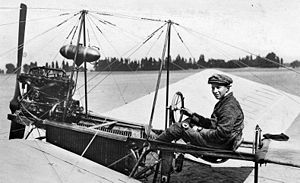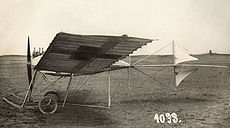Fokker Spin Video - Picture

|
|
Fokker Spin
Fokker Spin

Picture - Fokker in his Spin
Role: Expirmental Aircraft
Manufacturer: Fokker
Designed by: Anthony Fokker
First flight: 1910
Introduced: 1910
Number built: 25
The Fokker Spin was the first airplane built by Anthony Fokker. The many bracing wires made the plane resemble a giant spider, hence its name Spin (Dutch for "spider").
Fokker, while studying in Germany, built the Spin in 1910 together with Jacob Goedecker and business partner Franz von Daum, who procured the engine. The plane started out as an experimental design to provide Fokker a means to explore his interest in flying. While the first Spin was destroyed when von Daum flew it into a tree, the engine was still salvageable and was used in the second version.
A second version of the Spin was built soon afterwards, in which Fokker taught himself to fly and earned his pilot license. This plane was also irreparably damaged by von Daum.
In Fokker's third model, he gained fame in his home country the Netherlands by flying around the tower of the Sint-Bavokerk in Haarlem on August 31, 1911. He further added to his fame by flying on the birthday of Queen Wilhelmina. After this success he founded an aircraft factory and flight school near Berlin. There, the M.1 through M.4 were developed for the German Army based on the Spin.
The M.1 was a two-seat monoplane built in small numbers as the M.3. It was first flown in 1911 and by 1913 had been transferred to military flying schools. The M.2 was a true military version of the Spin. The airplane had a 75 kW (100 hp) Argus or Mercedes engine and was capable of 97 km/h (60 mph). The ten M.2s ordered for 299,880 Marks included 10 Daimler trucks to move the aircraft with the Army, per plans of the German General Staff at the time. The M.2 was a much refined aircraft with a streamlined fuselage, first flown in 1912. The M.4 was developed from the M.3, and included a nose wheel. It did not gain further sales.
From 1912 to 1913, a total of 25 Fokker Spins were built (including a few two-seat variants), used mostly for pilot training.

Picture - Fokker Spin, 3rd model
One of the last Spins was brought by Fokker to the Netherlands after World War I. It was incomplete and rebuilt in the early 1920s. During World War II, the plane was taken to an aviation museum in Berlin as a war trophy by the Germans occupying the Netherlands. After the war it was brought to Poland. Not until 1986 was it returned to the Netherlands where it was restored. A second surviving Spin was built by Fokker personnel in 1936 to commemorate the twenty-fifth anniversary of Anthony Fokker's first flight. Both of these planes are preserved at the Aviodrome aviation museum at Lelystad Airport, the Netherlands.
Construction
The fuselage simply consists of two wooden beams with cross members on which the pilot is seated and on which an Argus four-cylinder water-cooled engine is mounted in the front. The radiators are placed on the side of the fuselage. The wings and tail consist of two steel tubes with bamboo ribs. The landing gear is also constructed of steel tubing. The whole structure is held together with steel wire. Later versions have a more streamlined fuselage.
Fokker, a living history - Fokker Spin page
Fokker Spin Pictures
More aircraft.
Source: WikiPedia